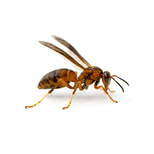
Lifestyles of Wasps
Solitary Wasps. Based on their living conditions, there are two types of wasps: solitary and social. Solitary wasps are idiosyncratic in terms of their nesting, predatory, and food habits. Most, about 97%, exist independently underground in tubular mud nests. They lay their eggs here and bring immobilized insects to feed the larvae. Different species often have different ways of attaining food, however. Some solitary wasps may build communal nests, but do not adopt the division of labor and the complex behavioral patterns of social wasps.
Solitary male wasps live longer than social male wasps. Because their nests are more widely distributed, finding a mate takes a little more effort and travel. Thus, they have to live longer to ensure they succeed.
Social Wasps. Social wasps are rarer. Most people find this hard to believe since wasp nests with lots of wasps are how most of us view wasps, but they only make up about 3% of the wasp species. These wasps are in the family Vespidae and typically fall into three groups: yellowjackets, hornets, and common paper wasps. Although yellowjackets often build their nests in rodent burrows or low-lying wall voids where they can remain hidden, hornets and common paper wasps build their nests above ground.
Yellowjackets and hornets are especially aggressive, whereas paper wasps usually only sting when threatened. You may be familiar with paper wasps if you’ve ever been on a picnic with sugary desserts or sweet drinks.
Living in groups, it is not surprising to discover that social wasps have a highly complex caste system. Members include one or more queens, drones, and infertile female wasps. Drones are haploid, developing from unfertilized eggs. With reduced organs and no job other than mating, they usually leave the nest afterward and die from starvation or dehydration. The infertile female wasps take care of the larvae and take care of building the nest.
Types of Wasps
Wasps are NOT a type of bee or an ant even though there are similarities. Like bees, they have slender, segmented bodies, stingers, and similar living habitats. Like ants, they have pointed abdomens, slender waists, and few hairs on their legs.
The number of species of wasps is estimated to be around 33,000. There are a lot of different kinds of wasps! More than 4,000 species exist in the United States.
Have you ever wondered if hornets and wasps were the same? The only real distinction between the hornet and its other wasp cousins is that they are larger and some are perhaps more aggressive. The largest hornet in the world is the Asian Giant Hornet, which is 1.5 to 2 inches in length! It is also the only species of social wasps known to apply a scent to direct its colony to a food source. It can also fly at a speed of 25 mph and as far as sixty miles in a single day!
Another interesting point on giant hornets: Their favorite snack is HONEY BEES! A small number of giant hornets can wipe out an entire colony of honey bees. One giant hornet can kill about forty bees per minute. However, one species of honey bees, the Japanese honey bee, has figured out a defensive measure. When a hornet scout is spotted, the honey bees attack her before she can release pheromones to attract other hornets. The honey bees swarm around her, vibrating their bodies at a tremendous rate, causing the temperature to rise so drastically, the hornet is roasted alive!
Specialized Wasps.
The Jewel Wasp attacks cockroaches and turns them into zombies! That’s right. Instead of feeding on them like most wasps, they use their stinger to inject a venom cocktail into their brain. It keeps the cockroach from making decisions, and it ultimately becomes a pawn of the jewel wasp.
After leading the zombie roach to a chamber, the jewel wasp lays one egg on its tractable host. Then it seals the cockroach inside the chamber with pebbles. The larva bores into the cockroach and feeds off its organs. Once the new wasp is ready to emerge from the chamber, it delivers the final blow to the cockroach.
The Cuckoo Wasp gets its name from the cuckoo bird. The wasp’s eponym doesn’t bother to build a nest. It lays its egg in the nest of other species. If the egg is not detected by the nest’s host, the hatched cuckoo bird will take over the nest by using its back to heave the other eggs over the side! The cuckoo wasp does the same thing. It lays its eggs in nests made by solitary wasps and then steals their food for its larvae.
Cicada Killers, which paralyze their victims, and Yellowjackets, whose aggressive protective tendencies are mimicked by other wasps to protect their nests, are two more specialized wasps about whom you might want to read.
Benefits of Wasps
Wasps help us through pollination, predation, and parasitism.
Let’s talk about parasitism first. Did you know about fig wasps? Here’s an intriguing account of the life and death of a fig wasp: Fig Wasps | Ask A Biologist (asu.edu). After reading about how these wasps lay eggs inside a fig, you may wonder if you’ve been eating wasps. Don’t panic. The answer is no. Ficin is a chemical produced by figs that breaks down the wasp bodies. Fig sap is even used in Central America to treat intestinal worms because of its ability to break down animal proteins.
Commercially cultivated fig trees are of the female parthenocarpic variety of the ancient common fig (Ficus carica) and do not need pollination to produce fruit. So, no chance of wasp bits in your fig!
As predators, the 33,000 species mentioned provide an impressive army! Biocontrol to protect crops is estimated to be worth at least $416 billion (US dollars) per year worldwide. Yet, the contributions of wasps have been largely ignored.
Researchers are now discovering that wasps play an important role as predators. In response to the infestation of emerald ash borer beetles in the nation’s forests, the U.S. Department of Agriculture coupled non-stinging wasps with a fungal pathogen as biocontrol back in 2011. Since then, the wasps have established themselves in some of these areas and are contributing to resolving the problem.
As pollinators, wasps are important, too. Seirian Sumner, an entomologist focused on wasps, says, “Some plants are completely reliant on wasps for pollination; we counted 164 plant species across six families. Most of these are orchids which have evolved to mimic female wasp pheromones—some even look like the back end of a female wasp. Males of the Scoliidae and Thynnidae are duped into copulating with a sexy-looking orchid, during which pollen is attached to him and transferred to another flower as he flits from one sexy deceptor to the next.” Wasps as pollinators have been shamefully ignored. With the current decline in pollinators, science needs to move wasps up higher on the list.
Fun Facts About Wasps
Wasps live everywhere but Antarctica. Wasps that sting can do so over and over again. Some, however, are nonstinging wasps. Solitary wasps reserve their stinging abilities for hunting. Only female wasps have stingers, while males do not. Because of this, female social wasp are the primary protectors of the nest and the queen.
Wasps make nests from paper. They chew up strips of bark and spit it out again to form a rough paper. Some wasps make nests in basements, sheds or underground in dark, cool places.
A colony of social wasps can contain between 5,000 and 10,000 wasps.
A social wasp queen starts a new colony each spring. She raises a few worker wasps first to make the nest larger and bring food. Then she starts laying eggs. A social wasp colony can grow to 50,000 wasps in one summer. In the fall, all the wasps die except for a few new queens. The new queens spend the winter in an old log or burrow. In the spring, they make new colonies, and the life cycle continues.
 RSS Feed
RSS Feed

